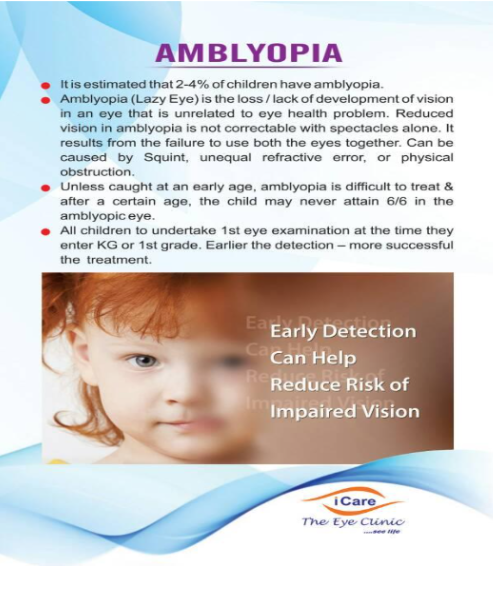Amblyopia (Lazy Eye)

Q. What is Amblyopia (Lazy Eye)?
Amblyopia is the decreased vision in one or both eyes due to abnormal development of vision in infancy or childhood. In Amblyopia, there may not be an obvious problem of the eye. Vision loss occurs because nerve pathways between the brain and the eye aren’t properly stimulated.
Q. Will glasses help a child with Amblyopia to see well?
Glasses may improve visual acuity to some degree but usually not completely. With Amblyopia the brain is ‘used to’ seeing a blurry image and needs to learn how to see better with that eye. With time however the brain may learn how to see and the vision may improve.
Q. How is Amblyopia treated?
One of the most important treatment of amblyopia is correcting the refractive error with consistent use of glasses and or contact lenses. Mainstay of amblyopia treatment is to enable the child to get a clearer image in brain especially with the weaker eye. If there is any pathology like paediatric cataract, that needs to be removed first. Patching or eyedrops (to blur the better seeing eye) forces the child to use the weaker eye.
Q. When should patching be used for amblyopia treatments?
Patching should only be done if ophthalmologist recommends. An ophthalmologist should regularly check how the patch is affecting the child’s vision. Patching usually works very well if started early and if the parent and the child follow the instructions carefully. It is important to patch the better seeing eye to allow the weaker eye to get stronger.
Q. Should patching be performed during school hours?
Dr Swati feels that in many instances school is an excellent time to patch taking advantage of a non-parental authority figure. Patching over during school hours also gives opportunity to learn to accept the differences between children.
Q. What if my child refuses to wear the patch?
Many children will resist wearing a patch at first. Successful patching may require persistent and plenty of encouragement from family members, neighbours, teachers etc. Children will often throw a temper tantrum but then they eventually learn not to remove the patch. Dr Swati feels that providing a positive reinforcement by giving a reward to the child for keeping the patch on for the prescribed time period often motivates them.
Every child’s eye has to be examined latest by three years of age even if there are no complaints regarding vision. this is because children are not expected to complain about eye problems. Various Eye conditions can be picked up at appropriate time leading to timely treatment and restoration of better vision
Contact Us
If you have any other questions or concerns, please contact us at:
The Eye clinic
Dr Swati Agarwal -The Eye Clinic
2A Motilal Basak lane
Kakurgachi
Kolkata, WB 700054
www.swatiagarwal.in
+91 9147714355
[email protected]
Important Note
This information is provided for general educational concepts only. Your specific circumstances, conditions, treatment approaches, and results may vary from those shown here. Additional information, instructions, and precautions are to be provided by and discussed with your eye care provider.
Need Urgent Help?
Call Us: